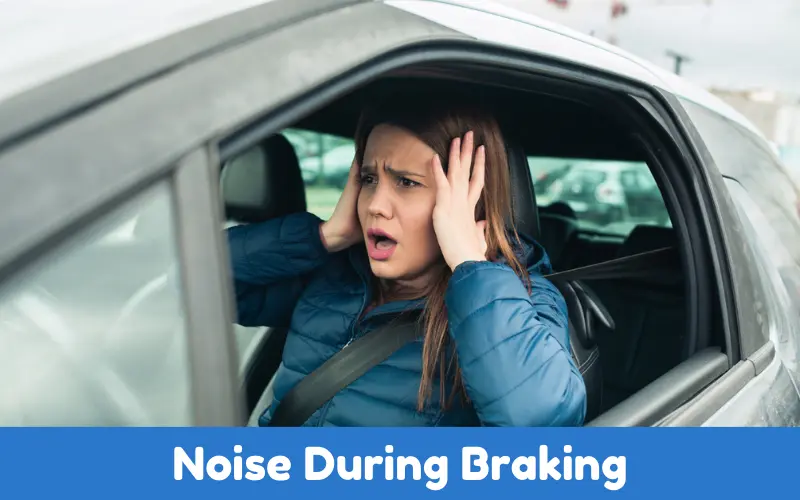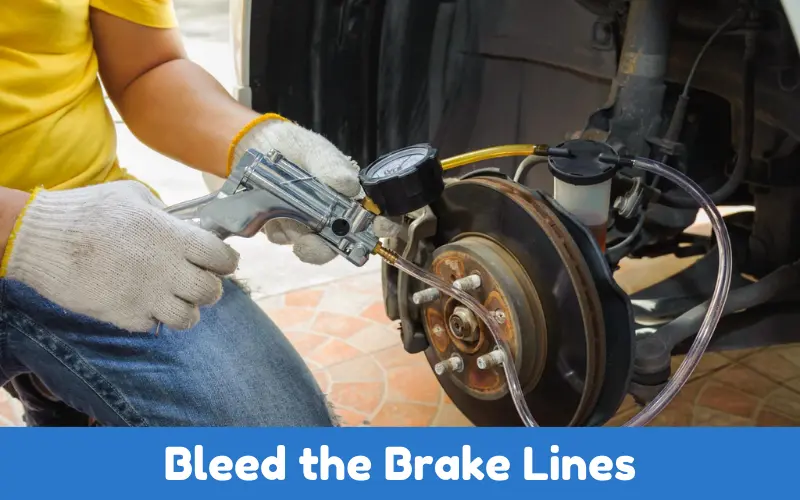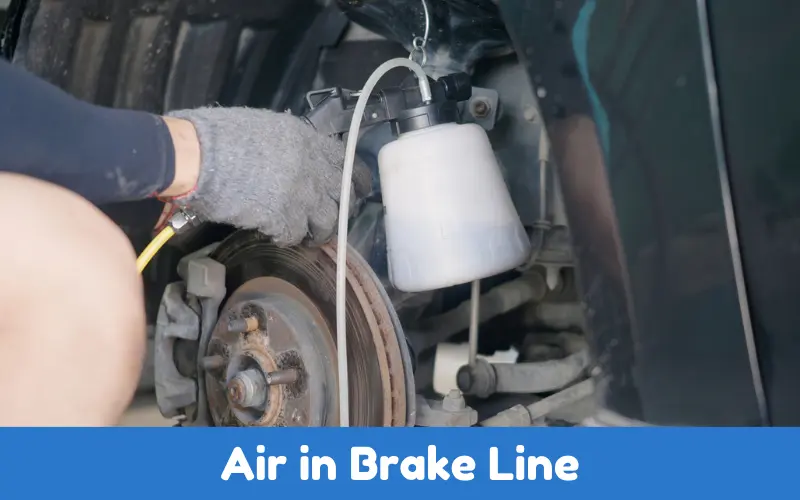When air enters a brake line, it is a serious condition that can reduce the effectiveness of your brakes and compromise the safe operation of the vehicle.
Symptoms of air in brake line typically include poor brakes, a soft brake pedal, a hard brake pedal, a pedal that goes completely to the floor, a brake fluid leak, and damage to the brake system.
In this blog, We’ll cover those symptoms in more depth below. Firstly, we’ll look at what you need to know to confirm if there’s air in your brake line.
Topic Summary
What Are The Symptoms of Air in Brake Line?
Air in the brake line is usually caused by a brake fluid leak, replacing brake fluid without properly bleeding the brakes, or failure of the brake system seals. If air gets in the brake lines, it can result in a soft or spongy feeling brake pedal.
Some common symptoms of air in brake line are listed below:
1. Spongy or Soft Brake Pedal
The most obvious symptom of an air bubble in the brake line is that the brake pedal might be spongy or seem ‘soft.’ When it combines with the brake fluid, the air compresses more easily than fluid, making it feel spongy or less firm.
2. Longer Stopping Distances
If your car takes longer to stop than usual, air has likely entered the brake lines. The working fluid of the braking system is a liquid called brake fluid, which the brake pads force through the lines and into a cylinder when you press the brake.
If your car takes longer to stop than usual, air has likely entered the brake lines. When this happens, the ability of the brake fluid to carry force from the pads through the lines into the cylinder diminishes, leading to longer stopping distances.
3. Unresponsive Brakes
If there is too much air in the brake line, it will result in a low pedal or a ‘spongy’ or ‘dead’ brake pedal that sits low to the floor, even with the brakes fully engaged, which would create a safety hazard.
4. Noise During Braking
When you hit your brakes, you’ll hear a squeal or grind if the air is in your brake lines, but that stems from the components in a system that would be fine if the air wasn’t there.

5. Brake Fluid Leaks
A visible leak of brake fluid around the wheels or underneath the car, or evidence of rusty bolts, may well indicate a potential brake fault, meaning air has been able to enter the brake lines. This would also likely be accompanied by other tell-tale symptoms, such as a soft brake pedal.
What Does Air in Brake Lines Sound Like?
When your brake lines have developed air pockets, there are some rather obvious symptoms you will hear and feel when you brake. You may hear a spongy, hissing, or squishy sound, especially if the brake pedal feels soft or floaty.
This noise comes from the secretion of air bubbles into the brake fluid, which is supposed to transmit force without loss. The bubbles get squashed when pressure is applied, squeezing out air and reducing the effective braking force.
You may also hear a much softer hissing sound if the air is leaking through the brake lines via small holes.
And, if the air in the lines has caused sufficient problems, you will likely hear a squeal or grind from the brakes when you apply them due to the car’s braking mechanism failing.
It is worth getting those symptoms resolved either by bleeding your brake lines or by getting them looked at by a mechanic so that they can operate correctly.
How To Diagnose and Fix Air in Brake Line
Air in brake line crates problem during press the brake pedal. It will not work properly. That’s why the process of diagnosing and fixing air in brake line issue are:
Check Brake Fluid Levels
First, check the brake fluid level in the reservoir – if it’s low, that could be a sign of a leak and could allow air into the system.
Bleed the Brake Lines
Using either manual brake pressure or an electric brake bleeder tool to force brake fluid through the system in order to expel trapped air is another easy way to remove air.

Inspect for Leaks
Look for brake fluid leaks anywhere along the brake lines, calipers, and master cylinder. Be sure to repair any found ones to keep air out of the system once more.
Consult a Professional Mechanic
If you can’t diagnose the problem yourself or do the brake system repairs, take the vehicle to a qualified mechanic who can diagnose the problem, perform the brake system repairs, and see that the braking system is safe for you to use.
How To Prevent Air in Brake Line
You should not allow air entering the brake lines to impact the performance of your brakes. Here are some steps to avoid this problem.
Regular Brake Fluid Checks: Check the brake fluid level from time to time and add more if needed. Make sure it is clean and free of contaminants.
Timely Brake Fluid Replacement: Inspect the brake fluid reservoir when the vehicle is cold, and always use only the recommended fluid specified by the manufacturer.
Note that fluid that’s past its recommended replacement service interval might have absorbed water, causing it to admit air into the system.
Proper Bleeding of Brake Lines: When adjusting the brakes or replacing fluid, make sure you bleed the air out of the system when servicing brake lines.
Inspect for Leaks: Check brake lines, fittings, and connections for signs of leakage or wear and repair any leaks that you find immediately to keep air out.
Maintain Brake System Components: Make sure that all seals, fittings, and parts are properly sealed and intact to avoid air ingress.
By doing so, you will combat brake pulsation by preventing air from getting into your brake system and enabling your brakes to work properly.
FAQs About Symptoms of Air in Brake Line
What Are the Main Symptoms of Air in Brake Line?
Symptoms of air in the brake system are a soft or spongy brake pedal, longer stopping distances, less efficient brakes, brakes that don’t work at all, odd noises coming from the brakes as you drive, and even possible brake fluid leaks from the brakes visible from underneath.
How Does Air Get Into the Brake Line?
Air could also get into the brake line through leaks in the brake fluid, by replacing fluid with the wrong type, or by broken seals. As brake fluid flows out from the master cylinder with air mixed in, the air bubbles in the line decrease the hydrostatic pressure in the line. This negatively affects brake performance.
Can I Drive with Air in the Brake Line?
You should not drive with air in the brake line. Firstly, it can dramatically decrease brake efficiency, which can increase stopping distances by a number of meters very often. This will be a serious safety risk. Secondly, you had better resolve the problem as soon as possible so you will not have to drive the car uncertainly.
How Do I Remove Air from the Brake Line?
In other words, air can be driven out of the system by bleeding the brake lines or forcing brake fluid through the system, pushing trapped air out in front of it. This is done semi manually or by using a brake bleeder.
When Should I Consult a Mechanic?
No, don’t drive yourself but do see your mechanic if you notice symptoms such as brake pedal sponginess or increased stopping distances, especially if you notice leaks of brake fluid. A professional technician can diagnose the problem and repair your vehicle according to specifications so that your brake system operates safely and properly.
Conclusion
Air in your braking system negatively affects your stopping distance and safety. You can identify the signs such as a soft pedal, ballooning stops, and brakes that refuse to engage.
With regular maintenance and timely repairs, your safety will not be compromised. If you suspect air in your brake lines, take immediate action to alert your mechanic and keep your brakes safe. Your driving future might depend on it.

